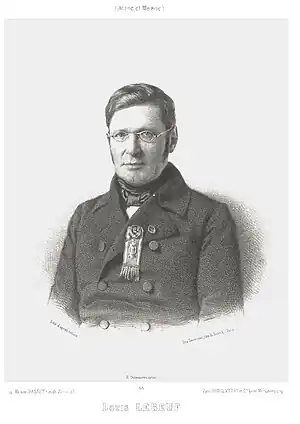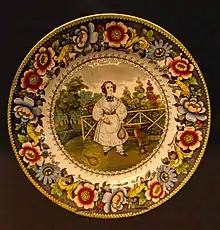Louis-Martin Lebeuf | |
|---|---|
 Louis-Martin | |
| Deputy | |
| In office 4 November 1837 – 12 June 1842 | |
| Member, National Legislative Assembly | |
| In office 13 May 1849 – 2 December 1851 | |
| Senator | |
| In office 26 January 1852 – 10 November 1854 | |
| Personal details | |
| Born | Lebeuf de Montgermont 26 May 1792 L'Aigle, Orne, France |
| Died | 10 November 1854 (aged 62) Pringy, Seine-et-Marne, France |
| Occupation | Banker, manufacturer politician |
Louis-Martin Lebeuf (26 May 1792 – 10 November 1854) was a French banker, faience manufacturer and right-leaning politician. He supported protectionist policies, and supported the coup d'etat that launched the Second French Empire under Napoleon III.
Family
Louis-Martin Lebeuf was born on 26 May 1792 in L'Aigle, Orne. His parents were Martin Lebeuf, a notary in L'Aigle, and Félicité Hilliere. On 12 November 1922 in Paris he married Claudine Athénaïs Marie Pollissard (1804–1887), daughter of Adrien Edmé Pollissard, a Paris merchant, and Alexandrine Marie Denise Pajot.[1] Their children were Adrien Louis Lebeuf (1824–1876), faience manufacturer, Alfred Louis Lebeuf (d. 1859), diplomat. and Alexandrine Louise Marie Lebeuf (1830–1865).[1]
Business career
Lebeuf's family had been notaries for over 200 years. Although he was meant to follow this career, he preferred commerce. He entered a banking house as a clerk, and by the age of 19 was one of the heads of the house. He was elected a judge of the Commercial Court and a member of the Paris Chamber of Commerce.[1] Lebeuf was a member of the Bank of France Discount Board from 1830 to 1836.[1] In 1835 he was appointed a regent of the Bank of France.[2] He was a regent of the Bank of France from 28 January 1836 until his death. He was also head of the banking house Lebeuf et Cie.[1]

Lebeuf was director of the Creil-Montereau faience works for the Société Lebeuf et Millet from 1840 until his death. The trademark was "LM et Cie".[1] Lebeuf purchased the château and estate of Montgermont at Pringy, Seine-et-Marne, and was ennobled.[1] The Association pour la défense du Travail national was formed to oppose the lowering of tariffs.[3] The council included Antoine Odier (President), Auguste Mimerel (vice-president), Joseph Périer (Treasurer) and Louis-Martin Lebeuf (Secretary). Members included Henri Barbet, Léon Talabot and Eugène Schneider.[4]
Political career
During the July Monarchy Lebeuf was a member of the General Council of Seine-et-Marne. He was made an Officer of the Legion of Honour.[2] Lebeuf was a member of the chamber of deputies from 4 November 1837 to 2 February 1839, representing the Seine-et-Marne department for the government majority. He was reelected for the same seat on the same platform from 2 March 1839 to 12 June 1842.[5] He failed to be reelected on 9 July 1842, and failed again on 1 August 1846.[2]
During the French Second Republic Lebeuf was a member of the National Legislative Assembly from 13 May 1849 to 2 December 1851, representing the Seine-et-Marne department.[5] In the legislature he sat on the right with the anti-republican majority. He supported the French expedition to Rome led by Charles Oudinot.[2] In 1851 he backed the coup-d'etat of Napoleon III.[2] During the Second French Empire he was a senator from 26 January 1852 until 10 November 1854.[5] Louis-Martin Lebeuf died on 10 November 1854 at the château de Montgermont in Pringy, Seine-et-Marne.[2]
Notes
- 1 2 3 4 5 6 7 Lebeuf – AABF.
- 1 2 3 4 5 6 Robert & Cougny 1891.
- ↑ Gille 1968, p. 76.
- ↑ The Foreign Quarterly Review 1847, p. 596.
- 1 2 3 Louis, Martin Lebeuf – Assemblée nationale.
Sources
- Gille, Bertrand (1968), La Sidérurgie française au XIXe siècle: Recherches histioriques (in French), Librairie Droz, ISBN 978-2-600-04046-4, retrieved 2017-07-04
- Lebeuf (in French), AABF: Association Artistique de la Banque de France, retrieved 2017-08-17
- "Louis, Martin Lebeuf", sycomore (in French), Assemblée nationale, retrieved 2017-08-17
- Robert, Adolphe; Cougny, Gaston (1891), "Louis, Martin Lebeuf", Dictionnaire des parlementaires français de 1789 à 1889 (in French), vol. IV. Lav-Pla, retrieved 2017-08-17
- The Foreign Quarterly Review, Treuttel, 1847, retrieved 2017-07-05